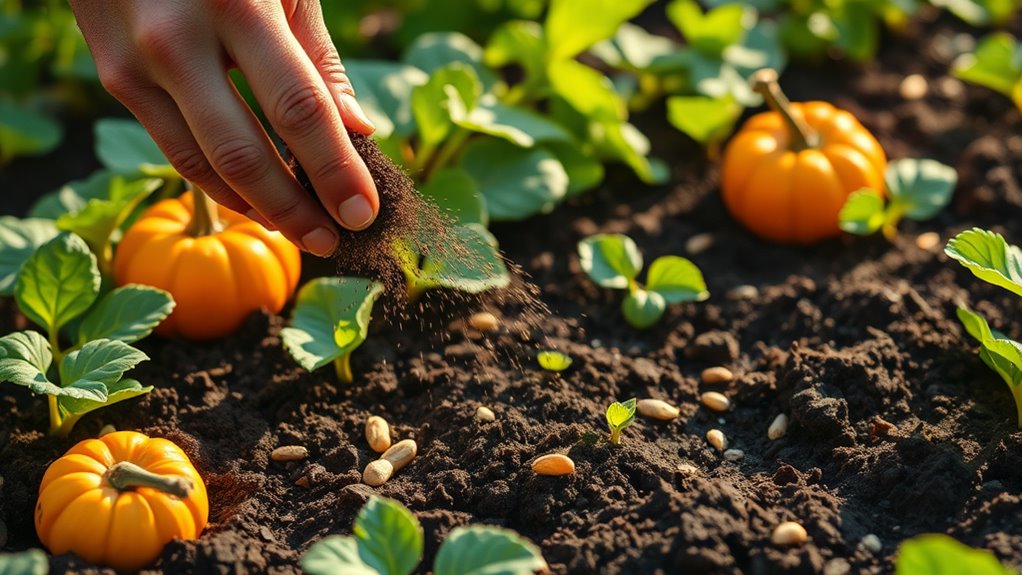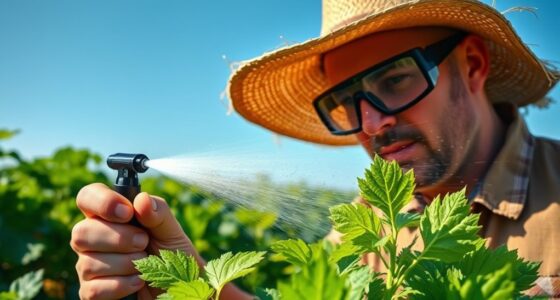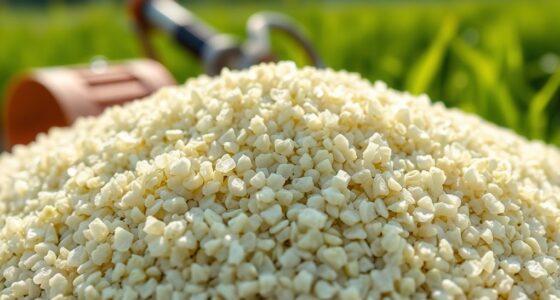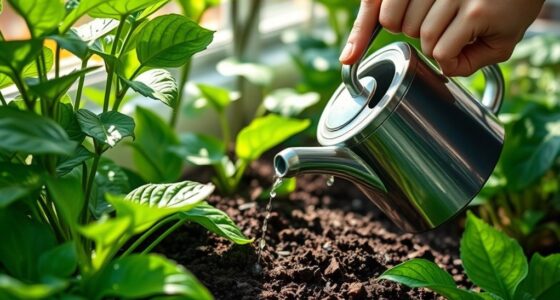To fertilize peanuts, potatoes, pumpkins, and sesame seeds effectively, analyze your soil first to identify nutrient levels. Apply tailored fertilizers at key growth stages: N, P, and K are essential, with timing during planting and flowering. Use appropriate methods like side dressing or banding to maximize uptake. Keep track of plant responses and adjust your practices as needed. For detailed guidance on each crop’s specific needs, continue exploring the best fertilization practices.
Key Takeaways
- Conduct soil testing to determine existing nutrient levels before applying crop-specific fertilizers.
- Apply nitrogen, phosphorus, and potassium at appropriate growth stages for each crop’s needs.
- Use side dressings or top-dressings during critical growth phases like flowering and fruiting.
- Match fertilizer types and application methods (broadcast, banding, side dressing) with crop requirements.
- Monitor plant responses regularly and adjust fertilization to optimize yield and prevent nutrient deficiencies.
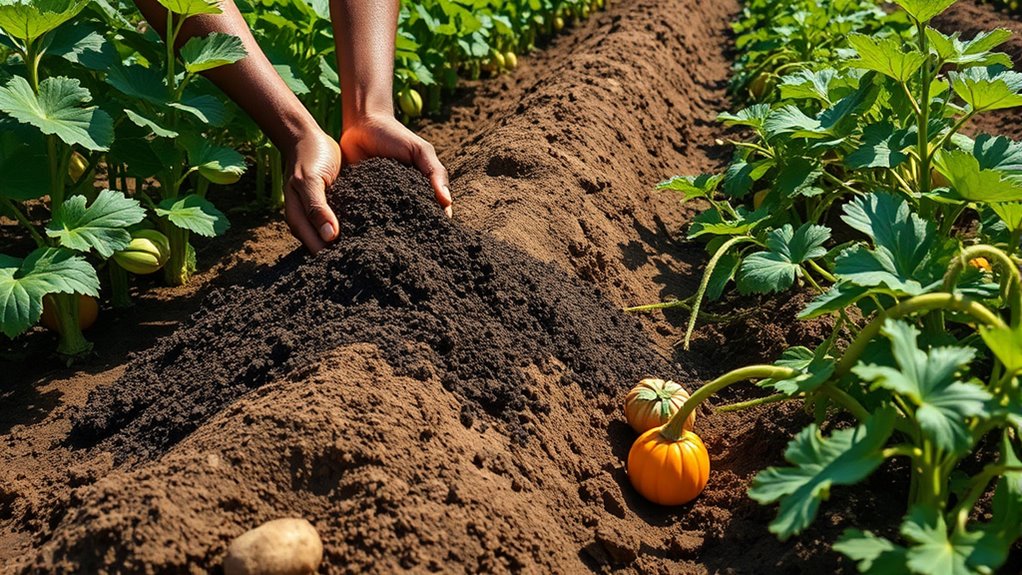
Fertilizing peanuts, potatoes, pumpkins, and sesame seeds is vital for maximizing yield and ensuring healthy growth. When you provide the right nutrients at the right time, you give your crops the foundation they need to thrive. Each of these crops has specific nutritional requirements, and understanding these needs helps you tailor your fertilization practices effectively. For instance, peanuts, as legumes, can fix nitrogen from the air, but they still benefit from additional fertilization, especially phosphorus and potassium, to support pod development. Potatoes require a balanced supply of nitrogen, phosphorus, and potassium to promote tuber growth and prevent diseases. Pumpkins, which are heavy feeders, demand high levels of nitrogen for foliage and fruit development, along with sufficient potassium to enhance fruit quality. Sesame seeds, on the other hand, thrive with moderate nitrogen but need phosphorus and potassium for proper seed formation and oil content.
Before fertilizing, you should analyze your soil to identify existing nutrient levels. This step helps you avoid over-fertilization, which can lead to nutrient runoff and environmental issues, or under-fertilization, which hampers growth. Conducting a soil test is a smart move that guides you in selecting the appropriate fertilizer types and quantities. Once you know your soil’s needs, you can plan a fertilization schedule aligned with the growth stages of each crop. For peanuts, apply a balanced fertilizer before planting and supplement with side dressings during flowering. Potatoes benefit from an application of phosphorus at planting and additional nitrogen during early growth stages. Pumpkins respond well to a side dressing of potassium and nitrogen as they develop their vines and fruits. Sesame seeds often require a basal application of phosphorus and potassium at planting, with a light nitrogen top-up if necessary during flowering.
Timing your fertilization is essential. Apply fertilizers when your plants are most receptive—usually during early growth or just before flowering—so the nutrients are readily available when your crops need them most. Use methods that maximize nutrient uptake, such as broadcasting, banding, or side dressing, depending on the crop and soil conditions. Remember, over-fertilizing can be just as harmful as under-fertilizing, leading to poor crop quality and environmental contamination. Always follow recommended application rates based on your soil test results and crop stage. Regularly monitor your plants for signs of nutrient deficiencies or excesses, and adjust your fertilization practices accordingly. With careful planning, precise application, and timely interventions, you’ll set your crops up for a productive and healthy season, ensuring a bountiful harvest of peanuts, potatoes, pumpkins, and sesame seeds.
Frequently Asked Questions
What Are the Best Organic Fertilizers for Each Crop?
When choosing organic fertilizers, you should consider each crop’s specific needs. For nutrient-rich feeds, compost and well-aged manure work well across the board. For pumpkins, use bone meal for phosphorus; for potatoes, apply kelp or seaweed extract for potassium. Sesame seeds benefit from balanced organic fertilizers like fish emulsion. Always test your soil first, and adjust fertilization based on crop requirements, ensuring healthy growth and ideal yields.
How Often Should I Fertilize During the Growing Season?
You should fertilize during the growing season based on your crop’s needs and growth stage. Generally, apply fertilizer every 3 to 4 weeks to provide consistent nutrients, but adjust frequency if you notice signs of deficiency or excessive growth. Always follow specific recommendations for each crop, and consider soil tests to tailor your fertilization schedule for best health and yield.
Are There Specific Micronutrients Essential for These Crops?
You might think plants just need water and sunlight, but surprise! They also crave micronutrients like zinc, boron, and manganese. These tiny nutrients play a huge role in healthy growth and yield. Without them, your crops might struggle, even if you fertilize generously. So, yes, paying attention to these essential micronutrients guarantees your plants thrive—because, after all, even the smallest elements make the biggest difference.
How Can I Improve Soil Fertility Naturally Before Planting?
To improve soil fertility naturally before planting, you can add organic matter like compost, manure, or cover crops. These enrich the soil with essential nutrients and improve its structure. Practice crop rotation to prevent nutrient depletion. Incorporate organic mulches and avoid synthetic chemicals. Testing your soil helps identify deficiencies, ensuring you add the right amendments. These steps create a healthy environment for your crops to thrive and yield better results.
What Signs Indicate Nutrient Deficiencies in These Plants?
Like a detective examining clues, you look for signs of nutrient deficiencies in your plants. Yellowing leaves often indicate nitrogen deficiency, while stunted growth suggests phosphorus issues. Pale or mottled foliage can signal potassium shortage. If you notice poor flowering or fruiting, it might be magnesium or calcium lacking. Keep an eye on these symptoms, as they guide you to the specific nutrients your plants need to thrive.
Conclusion
By fertilizing peanuts, potatoes, pumpkins, and sesame seeds properly, you can substantially boost your crop yields. Did you know that proper fertilization can increase productivity by up to 30%? This statistic highlights the essential role nutrients play in healthy plant growth. So, invest time in understanding your plants’ needs, and you’ll see better harvests and healthier crops. Remember, effective fertilization isn’t just about boosting numbers — it’s about nurturing your farm’s future.
